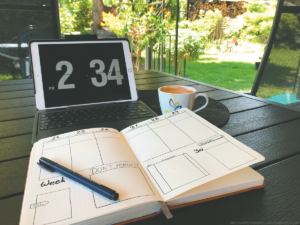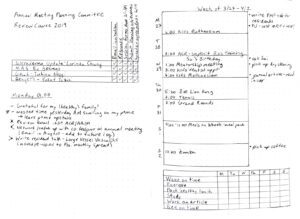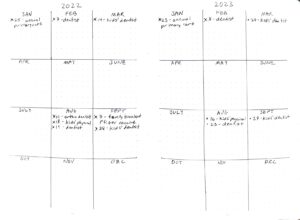 Let’s get to the point. Life is busy. Between my job as a rheumatologist, my volunteer work for the ACR, and parenthood, staying organized is a challenge. I’ve tried numerous organizational strategies whose logistics failed to meet my needs.
Let’s get to the point. Life is busy. Between my job as a rheumatologist, my volunteer work for the ACR, and parenthood, staying organized is a challenge. I’ve tried numerous organizational strategies whose logistics failed to meet my needs.
My online calendar was too small to add detail. Events I needed to track monthly or annually wouldn’t fit in the same window. I set reminders on my phone, which I snoozed then forgot. Large whiteboard calendars weren’t portable.
My to do list was so long that it took all my energy just to read it. I ignored it for days and nearly missed deadlines. My email was too crowded to collect tasks, and the search function never worked to my satisfaction. Haphazard sticky notes on my desk were quick and accessible, but lacked structure.
As a learner, I experimented with typing notes on my laptop. I tried to keep everything in one place, but while I created a computer document, I still reached for paper to capture tables and graphs. I struggled to recall details from a meeting or lecture, and my notes were difficult to find in my computer files.
I was carrying too much in my head. Trying to keep it all straight created stress and diluted my focus. I finally reclaimed my brain when my mom introduced me to an organizational system called the bullet journal.
The Concept
Initially I had my reservations. This system suggested I use a paper notebook, which felt like going backward to my middle school paper planner. My online research brought up websites of beautifully decorated pages with gorgeous calligraphy. I knew neither my journal nor my handwriting would ever result in a journal that looked like those examples.
As I have adopted a simplified version of this method, however, I’ve found that it has unified the fragments of my life. My bullet journal is my mobile office; it contains both my work and personal life. I can take notes quickly in a format that is flexible, portable, easily searchable and allows me a bird’s eye view of, or microscopic focus on, my calendar and tasks. I have a 24-month spread of annual appointments for my family next to daily and weekly spreads that cover both the spectrum and the granular detail of my personal and work lives.
My bullet journal has increased my mindfulness. I have tracked habits regarding exercise and study time, and trended stress levels and sleep quality. My journal is a place to collect the random thoughts that clutter my thinking. Writing in it is a meditation.
A bullet journal is much more than a sophisticated to do list. It’s a system that puts my tasks on autopilot so I can use my head space for creative and critical thinking. I can focus on what matters.
Start Your Own
Starting a bullet journal is simple. You need only two items: an 8×5.5″ journal with a dotted grid and a non-bleeding, fine-point (0.3 to 0.5 mm) pen. Ryder Carroll, the bullet journal’s creator, describes how to set up your bullet journal (BuJo for short) in his video.
Start with a title page and a page for your intentions for the journal. The following pages are the index, where you will reference the items in your journal by page number.
Next create your future log, where you can catalog tasks and events for future months. Information on facing pages is called a spread. Your first spread is your month view, with a calendar on the left page and to do list on the right. Each task is marked with a bullet in front. Finally, every day you will write a daily entry to collect your thoughts and lists in real time.
The magic happens when all the details of your life are logged, and you can begin to process them strategically. At the end of the weekend, I create a weekly page of events, and assign tasks from my monthly list to the day when they will be easiest to complete. At the beginning of each new month, I re-evaluate all uncompleted tasks and decide where to move them. The bullets make uncompleted tasks easy to find. I try to complete some immediately (draw an X through the bullet), but many will be copied into the next month’s spread (draw an arrow [→] through the bullet). Some won’t need to be addressed now, and I can free my mind by adding them to a future month in my future log.
Whenever I start a new monthly spread, I systematically review my goals and priorities. After copying items through several monthly cycles, the recognition of this pattern prompts me to take a closer look. Is the goal too large, abstract or not actionable? I may need to break it into smaller steps. Perhaps it isn’t the right time in my life to address something, and it needs to be added to my future log. Maybe the goal is an idea with merit but not worthy of my time and energy: With gratitude for this self-knowledge, I cross it out.
A paper journal isn’t required to use the bullet journal technique, but it works well for me. Scanning the index at the front, I can find my notes faster in my notebook than in my computer or phone. I appreciate the ability to quickly draw graphs and tables, underline text, draw arrows and circle key points. I have a spatial memory of where content lies on the page that serves as a secondary mental index. My recall is improved, which makes sense: Research has shown the benefits of writing notes by hand upon retention. I’m focused on processing content rather than recording it.

Small notebooks like this make good bullet journals.
I worried about losing my journal, until I realized that its contents are in my thoughts, my email or on my calendar. My priorities won’t change because I misplace a book.
In Sum
The simplicity of this technique won me over. Give it a try, and I’ll know you’ve joined the club when you adopt Ryder Carroll’s tip to use the elastic band of your journal for a pen holder. I can’t wait to see yours.
 Amanda Myers, MD, completed her fellowship in rheumatology at Emory University, Atlanta. She is now in practice with NorthShore University HealthSystem, Evanston, Ill.
Amanda Myers, MD, completed her fellowship in rheumatology at Emory University, Atlanta. She is now in practice with NorthShore University HealthSystem, Evanston, Ill.
Editor’s note: Dr. Myers receives no compensation from, and has no affiliation with, Bullet Journal or https://bulletjournal.com.


